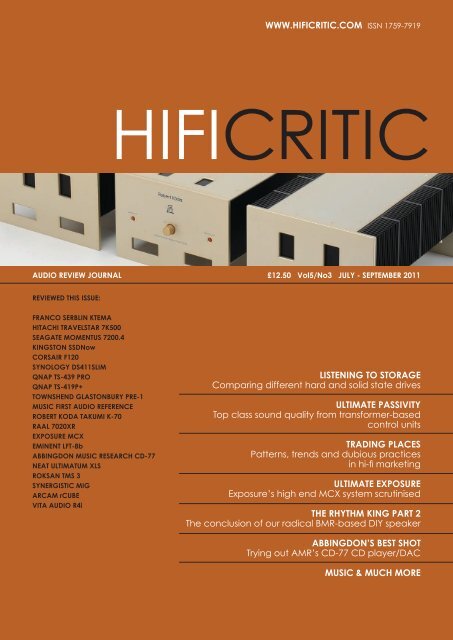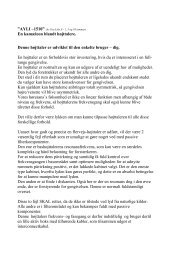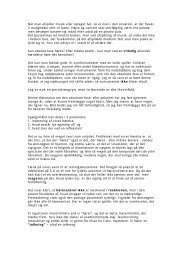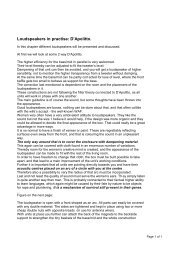Resistors vol5 no 3 HIFICritic Hi Res - Duelund Coherent Audio
Resistors vol5 no 3 HIFICritic Hi Res - Duelund Coherent Audio
Resistors vol5 no 3 HIFICritic Hi Res - Duelund Coherent Audio
You also want an ePaper? Increase the reach of your titles
YUMPU automatically turns print PDFs into web optimized ePapers that Google loves.
WWW.HIFICRITIC.COM ISSN 1759-7919<br />
HIFICRITIC<br />
AUDIO REVIEW JOURNAL £12.50 Vol5/No3 JULY - SEPTEMBER 2011<br />
REVIEWED THIS ISSUE:<br />
FRANCO SERBLIN KTEMA<br />
HITACHI TRAVELSTAR 7K500<br />
SEAGATE MOMENTUS 7200.4<br />
KINGSTON SSDNow<br />
CORSAIR F120<br />
SYNOLOGY DS411SLIM<br />
QNAP TS-439 PRO<br />
QNAP TS-419P+<br />
TOWNSHEND GLASTONBURY PRE-1<br />
MUSIC FIRST AUDIO REFERENCE<br />
ROBERT KODA TAKUMI K-70<br />
RAAL 7020XR<br />
EXPOSURE MCX<br />
EMINENT LFT-8b<br />
ABBINGDON MUSIC RESEARCH CD-77<br />
NEAT ULTIMATUM XLS<br />
ROKSAN TMS 3<br />
SYNERGISTIC MIG<br />
ARCAM rCUBE<br />
VITA AUDIO R4i<br />
LISTENING TO STORAGE<br />
Comparing different hard and solid state drives<br />
ULTIMATE PASSIVITY<br />
Top class sound quality from transformer-based<br />
control units<br />
TRADING PLACES<br />
Patterns, trends and dubious practices<br />
in hi-fi marketing<br />
ULTIMATE EXPOSURE<br />
Exposure’s high end MCX system scrutinised<br />
THE RHYTHM KING PART 2<br />
The conclusion of our radical BMR-based DIY speaker<br />
ABBINGDON’S BEST SHOT<br />
Trying out AMR’s CD-77 CD player/DAC<br />
MUSIC & MUCH MORE<br />
HIFICRITIC JULY | AUG | SEPT 2011 1
Crossover <strong>Res</strong>istor Sound<br />
CROSSOVER RESISTORS ARE CONSIDERED THE MOST ‘PASSIVE’ OF CROSSOVER NETWORK<br />
COMPONENTS, BUT THEY CAN STILL AFFECT THE SOUND OF A LOUDSPEAKER,<br />
AS MARTIN COLLOMS DISCOVERS<br />
30<br />
As electrical components go, from a simple<br />
technical viewpoint resistors are pretty well<br />
behaved. In factors like electron flow, specific<br />
resistance and tolerances (and with frequency response<br />
errors and distortions typically less than 0.0001%),<br />
they’re much better behaved than capacitors or<br />
inductors.<br />
Capacitors show self-resonance, frequencydependent<br />
dielectric loss and microphony; inductors<br />
have magnetic hysteresis, saturation and selfcapacitance,<br />
among several defects. Any of these may<br />
become audible under certain conditions in a revealing<br />
audio system. One might therefore suppose that<br />
resistors at least are audibly perfect, or at least very<br />
close to it.<br />
Nevertheless the metallurgy and the materials used<br />
in the physical construction of a resistor, especially<br />
the resistive element (which is usually an intentionally<br />
poorly conducting film or alloy) have an effect on<br />
sound quality, as does the thermal behaviour. While the<br />
differences are <strong>no</strong>t huge, we decided to try and find a<br />
way to audition them rationally and comparatively.<br />
Issues to take into account include resistance changes<br />
with power and thus temperature. <strong>Res</strong>istance wires<br />
are usually alloys of nickel and chromium, with some<br />
magnetic interactivity. Film MOX resistors employ a<br />
thin layer of metal oxide on a thermally conductive<br />
substrate, and this still needs to be connected to<br />
external wires. Sometimes these lead out wires are steel<br />
or copper-coated steel, to reduce heat flow from the<br />
hot element to the rest of the assembly. Composition<br />
resistors (such as <strong>Duelund</strong>s) use a rod of partly<br />
conducting, pressed and/or baked material of graphite<br />
and other material, a bit like pencil lead, with wrapped<br />
or compressed wire terminations. Pure metal foil types<br />
may bonded to the thermally conductive substrate and<br />
laser trimmed, such as the ultra costly power Vishays<br />
which are built for high stability with temperature and<br />
power. A wound component may have a small inductive<br />
component, and designers are sometimes exhorted to<br />
use <strong>no</strong>n-inductive types like the bifilar-wound Mills<br />
or Mundorfs; however, as seen in the test values, the<br />
inductance was essentially negligible.<br />
The opportunity to carry out listening tests on<br />
industry crossover power resistors (eg 5 -10W) are<br />
limited. However, my own Wilson <strong>Audio</strong> Sophia 3s<br />
conveniently have an access cover to a pair of mid and<br />
treble driver protection resistors, and this provides an<br />
u<strong>no</strong>fficial test bed. For this comparative test, 4.7ohm<br />
and 5.6ohm value resistors are perfectly acceptable<br />
standard substitution values. Although these are slightly<br />
removed from the Wilson calibration, they’re close<br />
e<strong>no</strong>ugh for critical auditioning after some degree of<br />
aural adjustment. (Our thanks to the suppliers for<br />
providing review samples.)<br />
As standard, Wilson fits Caddock MP821, a good<br />
quality close tolerance oxide film type, rated such that<br />
a potentially damaging over-current to the mid or<br />
treble results in harmless fusing of the resistor (then to<br />
be easily replaced across gold plated binding posts). I<br />
could <strong>no</strong>w substitute a variety of resistors of matched<br />
values and audition them in the k<strong>no</strong>wledge that they<br />
were directly in series with Wilson’s very high quality<br />
mid and treble drivers. The sonic signatures of these<br />
resistors, if any, would then be rendered accessible to<br />
listeners. The binding posts facilitated ready changeover<br />
and avoided the <strong>no</strong>rmally tricky process of getting into<br />
loudspeaker crossover networks.<br />
Back in 1977, when PM was working on <strong>Hi</strong>-Fi<br />
News, he translated and published those famous articles<br />
by Jean <strong>Hi</strong>raga on musicality and the sound of various<br />
audio components, especially cables. These generated<br />
cries of outrage from industry traditionalists who (along<br />
with their extant successors) believed that measurements<br />
can fully describe the listening experience; that resistors<br />
are essentially perfect, and consequently must all sound<br />
the same. <strong>Hi</strong>raga inspired me to carry out numerous<br />
tests on passive components subsequently, on capacitors,<br />
resistors and cables.<br />
THE RESULTS<br />
Worst case resistance tolerance was -5% for the CGS<br />
Meggitt (auditioned only in the midrange location);<br />
most were less than 2% or better (representing an<br />
installed volume change of less than 0.15dB). The<br />
inductance for these various values and types ranged<br />
from negligible to zero: the worst case result of 1.5uH<br />
will <strong>no</strong>t show a discernible effect until about 200kHz,<br />
so I consider that inductance is a negligible factor in<br />
these tests. The sound quality ratings are comparative<br />
for sound quality per se; there is <strong>no</strong> anchor for ‘<strong>no</strong><br />
resistor’ in this test.<br />
HIFICRITIC JULY | AUG | SEPT 2011
Caddock MP821: 53%<br />
The MP821 delivered an above average sound with<br />
positive dynamic expression detail and transparency,<br />
but was held back by a degree of added brightness<br />
which emphasised any sibilance and treble distortion, if<br />
present. It sounded a little ‘busy’, leading to a divided<br />
opinion.<br />
CGS Meggitt: 46%<br />
This resistor had a characteristic ceramic wire-wound<br />
sound, with roughness, brightness and grit, but also<br />
showed better clarity and rhythm than is usual for the<br />
type (perhaps the consequence of a mild increase in<br />
loudness).<br />
<strong>Duelund</strong> CAST: 79%<br />
“Did <strong>no</strong>t sound like a resistor”, the CAST sounded<br />
neutral, transparent, free from audible distortion or<br />
emphasis, with excellent clarity and detail, good plus<br />
dynamics, and very good rhythm. The <strong>no</strong>n-CAST<br />
construction <strong>Duelund</strong>s at half the price will clearly be<br />
also worth trying despite (or because of) their negative<br />
temperature coefficient, which is claimed to compensate<br />
to some degree for medium term compression due to<br />
voice coil heating. (For this to work properly, the two<br />
time constants would need to be matched, which seems<br />
unlikely.)<br />
KNP (WW): 45%<br />
The sound is reasonably well balanced, with some<br />
‘wiry’ and boxy coloration, slower bass, and moderate<br />
sibilance excess. It’s a typical industry result.<br />
Monacor Ceramic (WW): 40%<br />
The Monacor Ceramic had poorer depth, dynamics<br />
and detail than average plus some sibilant emphasis,<br />
and generally seemed less involving and musically<br />
interesting.<br />
Mundorf M<strong>Res</strong>ist SUPREME<br />
(bi-filar WW): 64%<br />
Mundorf’s M<strong>Res</strong>ist SUPREME showed some extra<br />
brilliance and slight ‘ringing’, but dynamics and clarity<br />
were well preserved, nicely expressive and transparent,<br />
with low subjective distortion, and above average<br />
rhythmic integrity.<br />
Mundorf MOX 10W: 51%<br />
This resistor gave a well balanced performance: <strong>no</strong>t<br />
objectionable, if a little bland musically, but with good<br />
neutrality and image depth.<br />
Mundorf MOX 5W: 60%<br />
This 5W MOX resistor sounded rather like the 10W<br />
version, but was clearly more interesting and involving<br />
musically, more open and transparent, and with better<br />
subjective rhythmic performance. Perversely, science<br />
would tend to predict the reverse in this comparison.<br />
Mundorf WW ceramic 25W: 43 %<br />
(mid only test)<br />
The sound here was <strong>no</strong>t so relaxed with some added<br />
moderate sibilance, loss of clarity and focus, with<br />
rougher treble sounds.<br />
Vishay Sfernice RCH25 series : 42%<br />
This Vishay is a mysterious sounding design. It’s quite<br />
neutral and accurate, but lacks dynamics and interest, so<br />
it’s inexplicably rather bland and uninvolving, leading<br />
to poorer sense of rhythm and a loss of transparency.<br />
Welwyn W24 : 36%<br />
This well established vitreous coated ‘oldie’ seems to<br />
be betrayed by its copper-steel lead-outs, and has a<br />
dulled, uninvolving sound that masks detail and impact,<br />
resulting in a below average score.<br />
CONCLUSIONS<br />
While it’s true to say that we were using a very high<br />
quality test platform, the differences we heard were<br />
greater than expected and led to clear preferences.<br />
<strong>Duelund</strong>’s mythic reputation was upheld: its products<br />
really do seem to provide the required attenuation<br />
without significantly disturbing the music quality.<br />
(Close tolerance to order.) While slightly coloured,<br />
Mundorf’s M<strong>Res</strong>ist also justified its reputation, this<br />
high specification component holding musical values<br />
essentially intact thanks to exceptional build quality.<br />
One surprise was the higher ranking of the 5W<br />
Mundorf MOX over their 10W example, but it was<br />
also clear that these two were of different construction,<br />
and both are very good value. The Caddock MP series<br />
film sounded familiar, as it should, and certainly had<br />
hi-fi credentials, but was <strong>no</strong>t the test favourite. Close<br />
tolerance values are available for this precision resistor.<br />
Industry generic ceramic wire-wounds do the job<br />
but are unremarkable, with some added subjective<br />
distortions, while the Welwyn W24 warhorse <strong>no</strong><br />
longer figures. Found to be rather self-effacing, Vishay’s<br />
Sfernice oxide film type was quite neutral but musically<br />
rather bland.<br />
Contacts<br />
◆ GROUP TEST<br />
MARTIN COLLOMS<br />
The Sound Practice<br />
www.thesoundpractice.com<br />
<strong>Hi</strong>fi Collective Ltd<br />
www.hificollective.co.uk<br />
RS Components<br />
uk.rs-online.com<br />
Parts Express<br />
www.parts-express.com<br />
MAKE TYPE ERROR POWER TECHNOLOGY SOUND INDUCTANCE APPROX<br />
PRICE £<br />
Caddock _________________________________________________________________________________<br />
MP821 0.2% 25W Metal oxide 53






